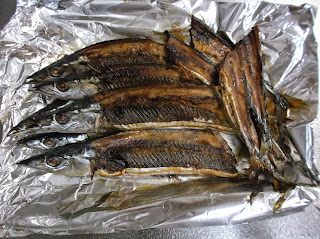Last Sunday, we received a box of 23 sanma (Pacific sauries) from a relative.
日曜日に親戚からサンマを一箱(23尾)いただきました。
Today, I decided to use them up. I salt-grilled two of them. To do so, I cut them in half diagonally at the anus, and sprinkled them with some salt (about 1/2 tsp).
今日は使い切ることにしました。二尾は塩焼きしました。そのため、肛門のところで斜めに半分にして、塩を少し(約小さじ半分)を振りました。
I decided to make the last six of them into kabayaki. I searched for a good way to fillet sanma. A common way is like this. I wanted to try a better, simpler way. I decided to try this one. You have to make a very shallow cut on the belly. Otherwise, the innards will be damaged.
残りの六尾は蒲焼きにすることにしました。サンマをさばくいい方法を探しました。一般的な方法はこんな感じです。もっといい、簡単な方法を試したいと思い、この方法を試すことにしました。お腹への切り込みはとても浅くないといけません。でないと、はらわたが傷つきます。
I accidentally make a rather deep cut on one (third from the top), damaging the innards.
間違って一つだけ(上から3番目)深めの切り込みを入れてしまい、はらわたが傷つきました。
I got twelve fillets.
切り身が12できました。
I cut each fillet into four pieces, dusted with flour, and pan-fried.
切り身をそれぞれ4つに切り、小麦粉をまぶし、フライパンで焼きました。
Then, I seasoned half the pieces with a mixture of 10 ml sake, 25 ml soy sauce, 25 ml mirin, and 2 tsp sugar.
次に、半分だけ、お酒10 ml、しょう油25 ml、みりん25 ml、砂糖小さじ2を混ぜたもので味付けしました。
I decided to leave the other half unseasoned.
残りの半分は味付けしないことにしました。
Done!
完成!
The soy sauce + mirin (and sake and sugar) never fails to appeal to the Japanese palate!
しょう油とみりん(+お酒+砂糖)は、いつも日本人の口に合います!
I grilled the two sanma in the toaster oven for well over 15 minutes.
二尾のサンマはオーブントースターで15分以上焼きました。
I sprinkled the fillets containing backbones with salt, and grilled then in the toaster oven.
中骨がある切り身は塩を振り、オーブントースターで焼きました。
We have to consume them in some way or other.
何らかの方法で食べないと。
How did I cook the other 15 (23 - 8) sanma? Here are photos of leftovers.
他の15尾(23 - 8)のサンマはどう料理したかって?残りの写真です。
Sanma simmered with tomato sauce:
トマトソースで煮込んだサンマ:
Sanma simmered with men tsuyu (noodle soup) and umeboshi (umeboshi seeds, actually):
麺つゆと梅干し(実際は梅干しの種)で煮込んだサンマ:
All these sanma dishes were tasty, and the sanma no kabayaki was the best.
どのサンマ料理も美味しかったですが、サンマの蒲焼きが一番美味しかったです。













7 comments:
Hiroyuki,
Your fish photos looks real nice ...But too bad I cannot try them as I am a vegetarian :-) ..By the way you give too much importance to the ratios of soy sauce and mirin which I noticed ...Whats the best formula/ratio and whats the best soy sauce, sake and mirin brands you suggest ? ...Here is America, I can get both kikoman ( American brewed without alcohol ) and Japanese import ( with alcohol ) and also Tamari sauce ...Is tamari better than soy sauce for flavour ...I am new to japanese cooking and like to try my hand at it ...atleast with vegetarian food...and I really like egg fried rice with Yamasa( japanese Import) soy sauce and roasted sesame seeds on top ...and chili sauce on the side ..by the way is the soy:mirin ratio diff for every recipe ?
23 fish? I guess I would have lit up my BBQ grill and invited all friends to help themselves and do their best (laugh).
Yes the soy sauce - mirin combination is wonderful. It goes so well with everything.
Dan: As for soy sauce and mirin ratios, here's a thread I started a long time ago:
http://forums.egullet.org/topic/103230-dashi-soy-sauce-mirin-ratios/
Sorry, I'm not familiar with soy sauce brands in the United States, and I can't recommend particular brands. Not all brands sold in Japan contain alcohol, I suppose.
I make sure that I get the Kikkoman brand whenever possible, because that's the best. I'm often dissatisified with cheaper brands.
I'm from Tokyo, and I'm not familiar with tamari or usukuchi (light-colored soy sauce). I use koikuchi (dark-colored) soy sauce for all dishes that call for soy sauce. Ask someone else, particular those living in Western Japan (Osaka, Kyoto, Kobe, etc.), and you may hear different opinions.
A common soy sauce-to mirin ratio is 1:1, but you can always adjust it to your own preferences.
By the way, I know from your wife's blog that you have very healthy vegetarian dishes!
Kiki:
It's hard for us to give away such fresh, big sanma for free (laugh)!
I've been serving sanma dishes for supper for four days in a row, and my daughter said last night that she was fed up with fish. Today, I will make meat dishes, together with leftover sanma dishes.
(I am again the main cook in the house for supper. My wife makes breakfast and bento.)
Thanks Hiroyuki ....Kikkoman is America's favourite soy sauce( no alcohol) and its home brewed in states Wisconsin and California...To me the domestic version tastes a little watered down as I like it a little darker/stronger and recently at my grocery store I saw Kikkoman( Japanese Version) with Alcohol ..I shall give it a try ...By the way "Jenny craig" one of the weight loss programs here in the US, endorse Kikkoman in all their dishes and use it instead of salt in all dishes possible...I use it even in making indian food ...
Today I made a fast and easy mushroom dish for my evening snack with tea...( basically marinate white button mushrooms in 2 table spoons kikkoman soy sauce, black pepper, 1/2 tea spoon of curry/garam masala , table spoon of chopped onions and green chilis with ginger julienne's and mixed all with 3-4 tablespoons of corn flour( not corn starch) ..and then deep fried it in oil ...Garnished with green onions ...This resembled japanese style tempura and this is basically a indo-chinese food which I love ...My dad likes the same recipe with cauliflower slices and is fondly called "Gobi manchurian " ...some folks even toss the whole bunch in some chili garlic sauce and a bit of ketchup ...taste was out of this world and kikkoman helped in bringing a ton of umami notes in the dish ....
Thanks for the links on the soy: mirin ratios as I think that's the real secret of japanese cusine ...:-)
Haha! The soy sauce and sake/mirin mixture appeals to every palate I know!
Lucky you to have such kind relatives (why my relatives never send food???? only my mum does).
I finally had a chance to taste sanma this year in Japan, but not grilled only on a kind of pressed sushi. It was slightly grilled I think and delicious.
I must say I have recently discovered another brand of soy sauce (not sure, but it might be Yamasa), straight from Japan and advised by the shop assistant (I have always used Kikkoman produced in Netherlands) and I preferred it but now alas they don't sell it any more... I use low-salt soy sauce because especially my husband makes everything 'swim' in soy sauce, so it's healthier I guess this way.
Sissi: Yamasa is a big brand too, but I prefer Kikkoman.
According to Wikipedia, Kikkoman has the largest market share of 26.3% in Japan, followed by Yamasa (11.0%).
You are lucky. I don't think I have ever tasted sanma sushi!
Haha! I thought it was actually a pity that I managed to taste it this way only (it wasn't raw though, it was "pressed" over the rectangular pieces of rice, not like in most popular sushi).
I think Kikkoman produced in Japan might be of higher quality than the one from Netherlands (the Japanese are definitely more demanding than Europeans!).
Post a Comment